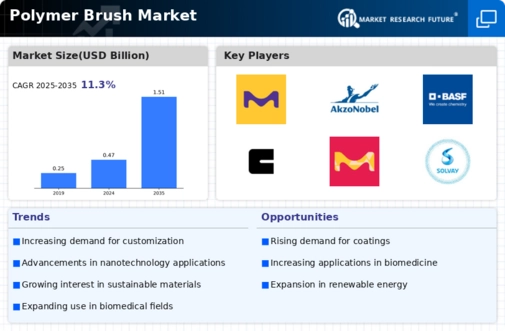Innovations in Material Science
The Polymer Brush Market is significantly influenced by ongoing innovations in material science. Researchers are exploring new polymerization techniques and materials that enhance the properties of polymer brushes, such as their mechanical strength and thermal stability. These advancements are likely to open new avenues for applications in various fields, including electronics, biomedical devices, and environmental technologies. The market for advanced materials is expected to grow, with polymer brushes playing a pivotal role in the development of next-generation products. As industries increasingly prioritize high-performance materials, the Polymer Brush Market may see a surge in demand for innovative polymer brush solutions. This trend indicates a dynamic landscape where continuous research and development efforts could lead to breakthroughs that redefine the capabilities of polymer brushes.
Expansion in the Electronics Sector
The Polymer Brush Market is poised for growth due to the expanding applications in the electronics sector. Polymer brushes are increasingly utilized in the fabrication of electronic devices, particularly in the development of flexible and stretchable electronics. The market for flexible electronics is expected to reach substantial figures in the coming years, driven by the demand for lightweight and portable devices. Polymer brushes can enhance the performance of electronic components by improving conductivity and stability. This trend suggests that the Polymer Brush Market will benefit from the ongoing advancements in electronics, as manufacturers seek innovative materials to meet the evolving needs of consumers. The integration of polymer brushes in electronic applications could lead to significant market opportunities and growth.
Rising Applications in Drug Delivery
The Polymer Brush Market is experiencing a notable increase in applications related to drug delivery systems. The unique properties of polymer brushes, such as their ability to modify surface characteristics and enhance biocompatibility, make them ideal candidates for targeted drug delivery. This sector is projected to grow significantly, with estimates suggesting a compound annual growth rate of over 10% in the coming years. As pharmaceutical companies seek innovative solutions to improve therapeutic efficacy, the demand for polymer brushes in drug delivery is likely to rise. Furthermore, advancements in polymer chemistry are enabling the development of more sophisticated brush architectures, which could further enhance their performance in medical applications. This trend indicates a robust future for the Polymer Brush Market, driven by the need for more effective and safer drug delivery mechanisms.
Growth in Coatings and Surface Modifications
The Polymer Brush Market is witnessing substantial growth in the coatings and surface modification sector. Industries such as automotive, aerospace, and electronics are increasingly adopting polymer brushes to enhance surface properties, including corrosion resistance, adhesion, and hydrophobicity. The market for polymer-based coatings is projected to reach several billion dollars by 2026, driven by the need for durable and high-performance materials. Polymer brushes can be tailored to achieve specific surface functionalities, which is particularly appealing in competitive markets where product differentiation is crucial. This trend suggests that the Polymer Brush Market will continue to expand as manufacturers seek innovative solutions to improve product performance and longevity. The versatility of polymer brushes in modifying surfaces could lead to their widespread adoption across various industrial applications.
Increasing Focus on Environmental Sustainability
The Polymer Brush Market is increasingly aligning with environmental sustainability initiatives. As industries face pressure to reduce their ecological footprint, the demand for eco-friendly materials is rising. Polymer brushes can be engineered to be biodegradable or derived from renewable resources, making them attractive options for companies aiming to enhance their sustainability profiles. The market for sustainable materials is projected to grow significantly, with polymer brushes potentially playing a crucial role in this transition. This shift towards sustainability may drive innovation within the Polymer Brush Market, as manufacturers seek to develop greener alternatives without compromising performance. The emphasis on environmental responsibility could lead to new regulatory frameworks that further promote the adoption of sustainable polymer brush technologies.


















Leave a Comment